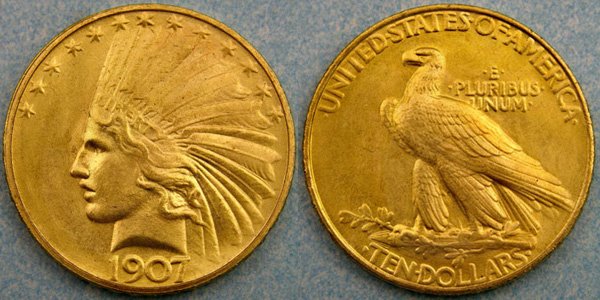Indian Head Gold Eagle
Source: My Coin Guides: The Indian Head Gold Eagles were the final series of $10 gold coins struck for circulation. The design by Augustus Saint Gaudens was introduced in 1907 and struck until the recall of federal gold in 1933. Circulation strikes were made at several Mints, sometimes with long intervals between the dates. The impact of melting has made some of the later issues of this series rare, presenting a challenge for anyone seeking to put together a complete collection.

All circulating gold coinage of the United States would be redesigned in 1907 or 1908. This was the result of the efforts of President Theodore Roosevelt, who had grown tired of the old designs, which had been in use since the late 1830’s and early 1840’s. He believed that the nation’s coinage should emulate the beauty and relief of ancient Greek coins. Renown sculptor Augustus Saint Gaudens would be responsible for the new designs of both the eagle and double eagle, working in close collaboration with President Roosevelt.
The final result for the ten dollar denomination was very artistic, yet somewhat incorrect, or at least incongruous, in its elements. The obverse of the Indian Head Eagle features a portrait of Liberty, facing left. She is wearing an Indian headdress with the word LIBERTY inscribed on the band. Typically such a headdress was only worn by male Native Americans. Thirteen stars, representing the original states of the Union, appear above with the date below.
The reverse of the coin features a bald eagle, with unnaturally long legs and neck, which are not anatomically correct. The eagle stands on a branch with thirteen leaves, with the denomination spelled as TEN DOLLARS below. The motto E PLURIBUS UNUM is in the field behind the neck, and UNITED STATES OF AMERICA is above. In 1907, a small number of coins were struck with a wire rim, which would protect the coins from wear. Ultimately, it was determined that this type of rim would not be suitable for circulation since the coins did not stack properly.
Charles Barber executed another version with a rounded rim and finally with a standard rim, also removing the periods between the motto on the reverse. In 1908, the motto IN GOD WE TRUST was added to the left field following public complaints about the omission of the words. No further design changes would take place for the series up through its conclusion in 1933, which coincided with the recall of all federal gold.
